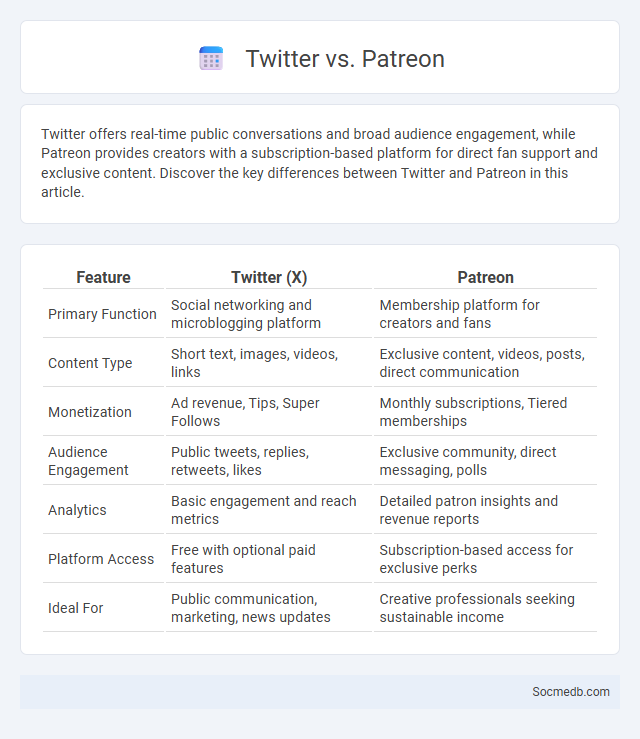
Photo illustration: Twitter vs Patreon
Twitter offers real-time public conversations and broad audience engagement, while Patreon provides creators with a subscription-based platform for direct fan support and exclusive content. Discover the key differences between Twitter and Patreon in this article.
Table of Comparison
| Feature | Twitter (X) | Patreon |
|---|---|---|
| Primary Function | Social networking and microblogging platform | Membership platform for creators and fans |
| Content Type | Short text, images, videos, links | Exclusive content, videos, posts, direct communication |
| Monetization | Ad revenue, Tips, Super Follows | Monthly subscriptions, Tiered memberships |
| Audience Engagement | Public tweets, replies, retweets, likes | Exclusive community, direct messaging, polls |
| Analytics | Basic engagement and reach metrics | Detailed patron insights and revenue reports |
| Platform Access | Free with optional paid features | Subscription-based access for exclusive perks |
| Ideal For | Public communication, marketing, news updates | Creative professionals seeking sustainable income |
Introduction to Creator Monetization Platforms
Creator monetization platforms empower individuals to transform social media content into sustainable income by offering tools for direct audience support, brand partnerships, and exclusive content sales. These platforms, such as Patreon, Ko-fi, and OnlyFans, enable creators to diversify revenue streams through subscriptions, one-time donations, and merchandise integration. Understanding how your unique content can leverage these monetization methods is essential for building a profitable online presence.
Overview: Twitter and Patreon at a Glance
Twitter serves as a dynamic microblogging platform where users share real-time updates, news, and engage in global conversations through tweets limited to 280 characters. Patreon offers creators a subscription-based platform enabling artists, podcasters, and influencers to monetize their content by providing exclusive access to patrons in exchange for financial support. Both platforms play pivotal roles in digital content dissemination and creator economy, with Twitter emphasizing public social interaction and Patreon focusing on sustainable creator funding.
Monetization Features on Twitter
Twitter offers various monetization features such as Super Follows, which allow users to charge subscribers for exclusive content, and Ticketed Spaces, enabling creators to sell access to live audio events. The platform also includes Tip Jar for direct payments from followers and Amplify Publisher for revenue sharing on video ads. These tools empower content creators to generate income while engaging with their audience effectively.
Monetization Features on Patreon
Patreon offers creators multiple monetization features including tiered memberships, exclusive content access, and direct fan support through monthly subscriptions. Creators can unlock revenue streams by providing personalized rewards, early releases, and community engagement tools. The platform's analytics and integration capabilities help optimize patron retention and growth, maximizing income potential.
Revenue Streams Comparison
Social media platforms generate revenue primarily through advertising, subscription services, and e-commerce integrations, with advertising accounting for nearly 80% of total income across major networks like Facebook and Instagram. Subscription models, including premium features on LinkedIn and YouTube, provide a growing but smaller revenue share, while emerging social commerce trends enable direct product sales within apps, enhancing monetization potential. Your business can leverage these diverse revenue streams by choosing platforms that align with your target audience and marketing goals for optimized ROI.
Audience Engagement Tools
Audience engagement tools on social media platforms enhance Your ability to interact directly with followers through polls, live streams, and interactive stories, increasing participation and building community loyalty. Features like comment moderation, chatbots, and personalized notifications provide real-time responses and foster meaningful conversations. Leveraging analytics within these tools helps optimize content by tracking audience behavior, ensuring Your social media strategy drives higher engagement rates.
Platform Fees and Payout Structure
Social media platforms often implement platform fees that can range from 5% to 30% depending on the service type and revenue model, directly impacting creators' earnings. Payout structures vary widely; some platforms offer weekly or monthly payments via bank transfers or digital wallets, while others require minimum earning thresholds before disbursing funds. Understanding platform-specific fee policies and payout schedules is crucial for maximizing revenue and maintaining cash flow in social media monetization.
Customization and Branding Options
Social media platforms offer extensive customization and branding options, allowing businesses to tailor their profiles with branded images, logos, and color schemes to ensure consistent visual identity. Customizable features such as profile banners, post formats, and highlight reels enhance brand recognition and engagement by creating a unique user experience. Enhanced branding tools, including custom URL handles, branded content tags, and integrated analytics, empower marketers to optimize campaigns and measure their social media impact effectively.
Community Building Capabilities
Social media platforms enhance community building capabilities by enabling you to connect with diverse groups, share ideas, and foster meaningful interactions. These tools offer features such as groups, forums, and live chats that facilitate engagement and strengthen relationships within targeted audiences. Leveraging social media's community-building functions helps cultivate loyal followers and drives sustained growth.
Choosing the Right Platform for Creators
Choosing the right social media platform for creators depends on where your target audience is most active and the type of content you produce, whether videos, images, or written posts. Platforms like Instagram and TikTok excel for visual storytelling and short-form videos, while YouTube is ideal for long-form content and tutorials. Understanding your niche and engagement goals ensures your content reaches the right viewers effectively, maximizing your growth and brand presence.
 socmedb.com
socmedb.com